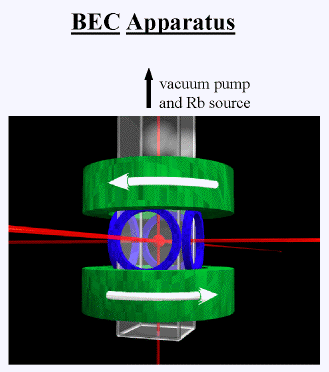How is BEC made? The Introduction
 It took 70 years to realize Einstein's concept of Bose-Einstein condensation
in a gas. It was first accomplished by Eric Cornell and Carl Wieman in
Boulder, Colorado in 1995. They did it by cooling atoms to a much lower
temperature than had been previously achieved. Their technique used laser
light to first cool and hold the atoms, and then these atoms were further
cooled by something called evaporative cooling.
It took 70 years to realize Einstein's concept of Bose-Einstein condensation
in a gas. It was first accomplished by Eric Cornell and Carl Wieman in
Boulder, Colorado in 1995. They did it by cooling atoms to a much lower
temperature than had been previously achieved. Their technique used laser
light to first cool and hold the atoms, and then these atoms were further
cooled by something called evaporative cooling.

 It looks like a pretty simple piece of equipment for such an important
experiment. Is that really all there was?
It looks like a pretty simple piece of equipment for such an important
experiment. Is that really all there was?
 Not exactly. There is a table full of equipment associated with the lasers,
and they needed to produce exactly the right color of light. Also there is a
computer and a bunch of other electronic equipment for controlling everything
and making measurements. Still, it was a pretty simple and inexpensive
apparatus compared to many physics experiments today. It only cost about
$50,000-100,000 for the equipment, but that does not include a lot of hard
work that went into putting it all together!
Not exactly. There is a table full of equipment associated with the lasers,
and they needed to produce exactly the right color of light. Also there is a
computer and a bunch of other electronic equipment for controlling everything
and making measurements. Still, it was a pretty simple and inexpensive
apparatus compared to many physics experiments today. It only cost about
$50,000-100,000 for the equipment, but that does not include a lot of hard
work that went into putting it all together!
 So how cold do the atoms have to be to reach BEC?
So how cold do the atoms have to be to reach BEC?
 Less than one millionth of a degree above Absolute Zero, which is millions of
times colder than the lowest temperature found in the depths of outer space.
(Click here for more information about
Temperature)
Less than one millionth of a degree above Absolute Zero, which is millions of
times colder than the lowest temperature found in the depths of outer space.
(Click here for more information about
Temperature)
 That sounds pretty cold. How do they do it?
That sounds pretty cold. How do they do it?
 Well it takes two stages. Sort of like taking a pan out of a hot oven and
letting it cool off in air first, and then dunking it in ice water. Except
the first step here is to shine laser light on the atoms to cool them to about
1/10,000 of a degree above Absolute zero, and the second step is to
evaporatively cool them further.
Well it takes two stages. Sort of like taking a pan out of a hot oven and
letting it cool off in air first, and then dunking it in ice water. Except
the first step here is to shine laser light on the atoms to cool them to about
1/10,000 of a degree above Absolute zero, and the second step is to
evaporatively cool them further.






